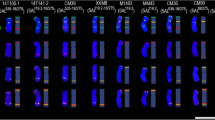Abstract
The rice aneuploids with telochromosomes are ideal genetic stocks for chromosome arm identification and microdissection. A rice telo-tetrasomic line with two extra short arms of chromosome 5 (5S) was used in the present study. The amrs of 5S were microdissected from the prometaphase cells in mitosis and amplified with linker adaptor PCR (LA-PCR). The amplified fmgments, ranging from 200–3000 bp, were confirmed to be from the rice chromosome arm 5S by the rice STS and miamatellite markers.
Similar content being viewed by others
References
Scalenghe, F., Turco, E., Edstrom, J. E.et al., Microdissection and cloning of DNA from a specific region ofDrosophila melunogaster polytene chromosome,Chromosoma, 1981, 82: 205.
Kao, F. T., Chromosome microdissection and microcloning in human molecular genetics,Somatic Cell and Molecular Genetics, 1987, 13: 375.
Pirotta, V., Hadfield, C., Pretorius, G. H. J., Microdissection and cloning of thewhite locus and the 3B1–3C2 region of theDrosophila X chromosome, TheEMBO Journal, 1983, 2: 927.
Rohme, D., Fox, H., Herrmann, B.et al., Molecular clones of the mouse t-complex derived from microdissected metaphase chromosomes,Cell, 1984, 36: 783.
Schondelmaier, J., Martin, R., Jahoor, A.et al., Microdissection and microcloning of the barley (Hordeum vulgare L.) chromosome 1SH,Theor. Appl. Genet., 1993, 96: 629.
Busch, W., Martin, R., Herrmann, R. G.et al., Repeated DNA sequences isolated by microdissection. I. Karyotyping of barley (Hordeum vulguru L.), Genome, 1995, 38: 1082.
Albani, D., Cote, M. J., Armstrong, K. C.et al., PCR amplification of microdissected wheat chromosome arms in a simple single tube reaction,Plant J., 1993, 4: 899.
Vega, J. M., Abbo, S., Feldman, M.et al., Chromosome painting in plants:In situ hybridization with a DNA probe from a specific microdissected chromosome arm of common wheat,Proc. Natl. Acad. Sci. USA, 1994, 91: 12041.
Houben, A., Kynast, R. G., Heim, U.et al., Molecular cytogenetic characterisation of the terminal heterochromatic segment of the Echromosome of rye (Secale cereale).Chromosoma, 1996, 105: 97.
Sandery, M. J., Forster, J. W., Macadam, S. R.et al., Isolation of a sequence common to A- and B-chromosome of rye (Secale cereale) by microcloning,Plant Mol. Biol. Rep., 1991, 9: 21.
Chen, Q. F., Amstrong, K., Characterization of a library from a single microdissected oat (Avena sativa L.) chromosome,Genome, 1995, 38: 706.
Ponelies, N., Stein, N., Weber, G., Microamplification of specific chromosome sequences: an improved method for genome analysis,Nucleic Acids Res., 1997, 21: 3555.
Pich, U., Houbean, A., Fuch, S. J.et al., Utility of DNA amplified by degenerate oligonucleotide-primed PCR (DOP-PCR) from the total genome and defined chromosomal regions of field bean,Mol. Gen. Genet., 1994, 243: 173.
Jamilena, M., Garrido-Ramos, M., Rejon, M. R.et al., Construction of repeated sequences from microdissected B chromosomes ofCrepis capillaris, Chromosoma, 1995, 104: 113.
Hu, Z. M., Cui, L. H., Wang, L. L.et al., Isolation of single chromosomes and chromosomal fragments inLilium regale, Acta Genetica Sinica (in Chinese), 1997, 24: 278.
Fukui, K., Current status in rice chromosome research,Rice Genetics Newsletter, 1996, 13: 27.
Cheng, Z. K., Yu, H. X., Li, X.et al., A new set of primary trisomics in indica rice, its breeding and cytological investigation,Acta Genetic Sinica, 1996, 23: 263.
McCouch, S. R., Kochert, G., Yu, Z. H.et al., Molecular mapping of rice chromosome,Thoer. Appl. Genet., 1988, 76: 815.
Inoue, T., Zhong, H. S., Miyao, A.et al., Sequence-tagged sites (STS) as standard landmarkers in the rice genome,Theor. Appl. Genet., 1994, 89: 728.
Chen, X., Temnykh, S., Xu, Y.et al., Development of a microsatellites framework providing genomewide coverage in rice (Oryza sativa L.),Theor. Appl. Genet., 1997, 95: 553.
Author information
Authors and Affiliations
About this article
Cite this article
Cheng, Z., Yan, H., Dang, B. et al. Microdissection and amplification of the chromosome arm 5S in a rice telo-tetrasomic. Chin. Sci. Bull. 43, 590–594 (1998). https://doi.org/10.1007/BF02883647
Received:
Issue Date:
DOI: https://doi.org/10.1007/BF02883647




